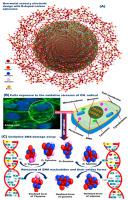当前位置:
X-MOL 学术
›
Anal. Chim. Acta
›
论文详情
Our official English website, www.x-mol.net, welcomes your
feedback! (Note: you will need to create a separate account there.)
Non-metal sensory electrode design and protocol of DNA-nucleobases in living cells exposed to oxidative stresses
Analytica Chimica Acta ( IF 5.7 ) Pub Date : 2021-01-01 , DOI: 10.1016/j.aca.2020.11.004 Mohammed Y. Emran , Sherif A. El-Safty , Mahmoud M. Selim , Takashi Minowa , Ahmed Elmarakbi , Mohamed A. Shenashen
Analytica Chimica Acta ( IF 5.7 ) Pub Date : 2021-01-01 , DOI: 10.1016/j.aca.2020.11.004 Mohammed Y. Emran , Sherif A. El-Safty , Mahmoud M. Selim , Takashi Minowa , Ahmed Elmarakbi , Mohamed A. Shenashen

|
Sensory protocols for evaluation of DNA distortion due to exposure to various harmful chemicals and environments in living cells are needed for research and clinical investigations. Here, a design of non-metal sensory (NMS) electrode was built by using boron-doped carbon spherules for detection of DNA nucleobases, namely, guanine (Gu), adenine (Ad), and thymine (Th) in living cells. The key-electrode based nanoscale NMS structures lead to voids with a facile diffusion, and strong binding events of the DNA nucleobases. Furthermore, the NMS geometric structures would significantly create electrode surfaces with numerous centrally active sites, curvature topographies, and anisotropic spherules. The NMS shows potential as sensitive protocol for DNA-nucleobases in living cells exposed to oxidative stresses. In one-step signaling assay, NMS shows high signaling transduction of Gu-, Ad-, and Th-DNA nucleobases targets with ultra-sensitive and low detection limits of 3.0, 0.36, and 0.34 nM, respectively, and a wide linear range of up to 1 μM. The NMS design and protocol show evidence of the role of surface construction features and B-atoms incorporated into the graphitic carbon network for creating abundant active sites with facile electron diffusion and heavily target loads along with within-/out-plane circular spheres. Indeed NMS, with spherule-rich interstitial surfaces can be used for sensitive and selective evaluation of damaged-DNA to various dysfunctional metabolism in the human body.
中文翻译:

暴露于氧化应激的活细胞中 DNA 核碱基的非金属感觉电极设计和方案
研究和临床调查需要用于评估由于暴露于活细胞中的各种有害化学物质和环境而导致的 DNA 失真的感官协议。在这里,通过使用掺硼碳小球来构建非金属感觉 (NMS) 电极,用于检测活细胞中的 DNA 核碱基,即鸟嘌呤 (Gu)、腺嘌呤 (Ad) 和胸腺嘧啶 (Th)。基于关键电极的纳米级 NMS 结构导致空隙容易扩散,并导致 DNA 核碱基的强结合事件。此外,NMS 几何结构将显着创建具有许多中心活性位点、曲率拓扑和各向异性球粒的电极表面。NMS 显示出作为暴露于氧化应激的活细胞中 DNA 核碱基的敏感协议的潜力。在一步信号分析中,NMS 显示出 Gu-、Ad- 和 Th-DNA 核碱基目标的高信号转导,具有分别为 3.0、0.36 和 0.34 nM 的超灵敏和低检测限,以及高达 1 μM 的宽线性范围。NMS 设计和协议显示了表面结构特征和 B 原子在石墨碳网络中的作用的证据,用于创建丰富的活性位点,具有容易的电子扩散和重度目标负载以及平面内/平面外圆形球体。事实上,具有富含小球的间隙表面的 NMS 可用于敏感和选择性地评估受损 DNA 对人体各种功能障碍的代谢。NMS 设计和协议显示了表面结构特征和 B 原子在石墨碳网络中的作用的证据,用于创建丰富的活性位点,具有容易的电子扩散和重度目标负载以及平面内/平面外圆形球体。事实上,具有富含小球的间隙表面的 NMS 可用于敏感和选择性地评估受损 DNA 对人体各种功能障碍的代谢。NMS 设计和协议显示了表面构造特征和 B 原子在石墨碳网络中的作用的证据,用于创建丰富的活性位点,具有容易的电子扩散和重度目标负载以及平面内/平面外圆形球体。事实上,具有富含小球的间隙表面的 NMS 可用于敏感和选择性地评估受损 DNA 对人体各种功能障碍的代谢。
更新日期:2021-01-01
中文翻译:

暴露于氧化应激的活细胞中 DNA 核碱基的非金属感觉电极设计和方案
研究和临床调查需要用于评估由于暴露于活细胞中的各种有害化学物质和环境而导致的 DNA 失真的感官协议。在这里,通过使用掺硼碳小球来构建非金属感觉 (NMS) 电极,用于检测活细胞中的 DNA 核碱基,即鸟嘌呤 (Gu)、腺嘌呤 (Ad) 和胸腺嘧啶 (Th)。基于关键电极的纳米级 NMS 结构导致空隙容易扩散,并导致 DNA 核碱基的强结合事件。此外,NMS 几何结构将显着创建具有许多中心活性位点、曲率拓扑和各向异性球粒的电极表面。NMS 显示出作为暴露于氧化应激的活细胞中 DNA 核碱基的敏感协议的潜力。在一步信号分析中,NMS 显示出 Gu-、Ad- 和 Th-DNA 核碱基目标的高信号转导,具有分别为 3.0、0.36 和 0.34 nM 的超灵敏和低检测限,以及高达 1 μM 的宽线性范围。NMS 设计和协议显示了表面结构特征和 B 原子在石墨碳网络中的作用的证据,用于创建丰富的活性位点,具有容易的电子扩散和重度目标负载以及平面内/平面外圆形球体。事实上,具有富含小球的间隙表面的 NMS 可用于敏感和选择性地评估受损 DNA 对人体各种功能障碍的代谢。NMS 设计和协议显示了表面结构特征和 B 原子在石墨碳网络中的作用的证据,用于创建丰富的活性位点,具有容易的电子扩散和重度目标负载以及平面内/平面外圆形球体。事实上,具有富含小球的间隙表面的 NMS 可用于敏感和选择性地评估受损 DNA 对人体各种功能障碍的代谢。NMS 设计和协议显示了表面构造特征和 B 原子在石墨碳网络中的作用的证据,用于创建丰富的活性位点,具有容易的电子扩散和重度目标负载以及平面内/平面外圆形球体。事实上,具有富含小球的间隙表面的 NMS 可用于敏感和选择性地评估受损 DNA 对人体各种功能障碍的代谢。











































 京公网安备 11010802027423号
京公网安备 11010802027423号